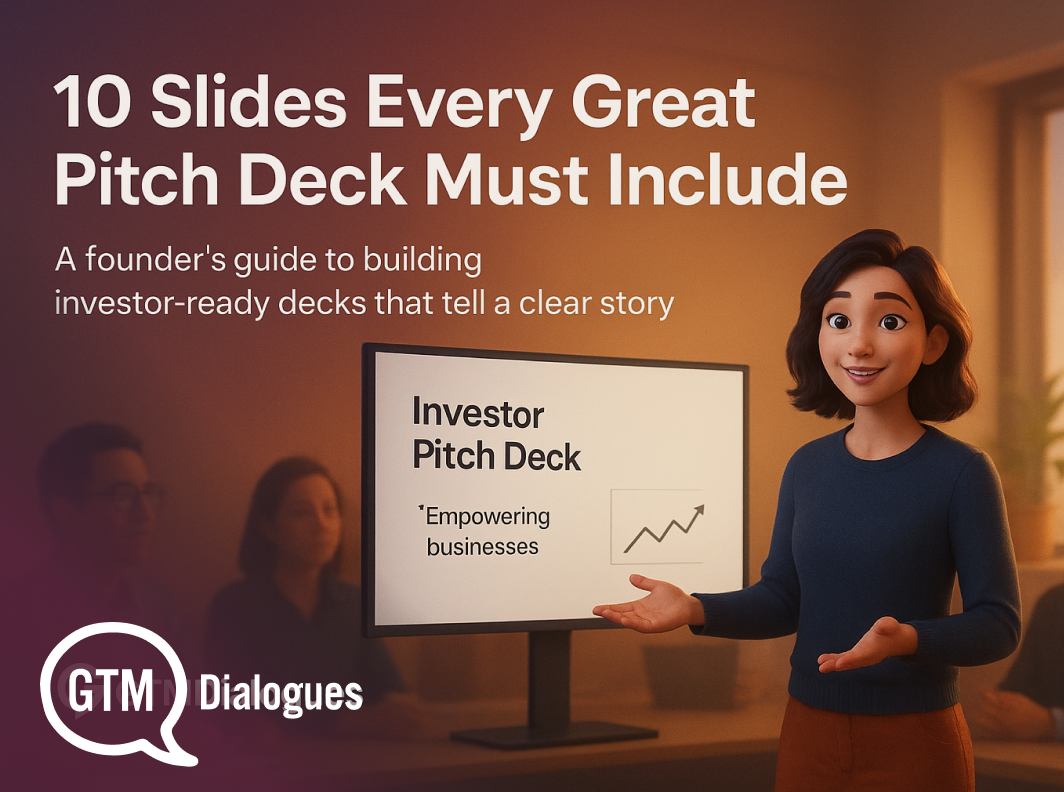The most common fundraising mistake early-stage founders make? Picking a round size based on what “feels right” or what they think investors expect.
The better approach: work backward from your business needs.
You should raise enough capital to fund 18–24 months of operations, with a clear plan to reach specific milestones that unlock a higher valuation for the next round. These milestones could include product readiness, revenue traction, customer acquisition, or GTM repeatability depending on your stage.
But here’s the nuance: more money isn’t always better.
Raising too little puts you at risk of running out of cash before hitting critical milestones.
Raising too much leads to unnecessary dilution and unrealistic expectations from investors.
The sweet spot lies in:
- Building a detailed financial plan covering hiring, GTM, and product costs
- Adding a 6-month buffer for your next fundraise
- Avoiding vanity-driven round sizes
If you're not sure how to scope this, start by modeling different fundraising scenarios based on how fast you want to grow, and how much risk you're willing to take.
The goal isn't to raise the most. It's to raise what your business actually needs. No more, no less.
The 5 Startup Funding Stages (and What They’re For)
Each funding stage is designed to match a specific risk profile and growth milestone. If you raise too early or too late, you risk misaligning capital with what your business actually needs.
Here’s a breakdown of the most common stages and their purpose:
A useful rule of thumb: Pre-seed to Seed is about building. Series A and beyond is about scaling.
Don’t jump ahead too fast. Investors at each stage expect different proof points, from an MVP and early traction at seed to clear metrics and repeatability at Series A.
Understanding where you are, and what’s expected, can keep your raise focused, and your messaging sharp.
How to Determine How Much You Should Raise
There’s no magic number. The right raise amount comes from a simple question:
What do you need to achieve in the next 18–24 months to unlock your next valuation milestone?
Start by defining the core milestones this round should help you achieve:
- Product development goals (MVP, v2, integrations)
- GTM validation or scaling (first customers, CAC/LTV benchmarks, sales repeatability)
- Key hires (founding engineer, growth lead, customer success)
- Revenue or usage targets (MRR milestones, retention benchmarks)
Then, map out the cost to hit each milestone, including:
- Hiring and salaries
- Marketing and paid experiments
- Infrastructure, tools, and vendor spend
- Runway buffer of at least 6 months
Build a financial model (even a simple one in Excel) that shows:
- Monthly burn
- Headcount and hiring plan
- Forecasted revenue (if applicable)
- Target runway
What you’re doing is setting the operating plan first, and funding it second.
Avoid these common traps:
- Picking a round size based on what other startups raised
- Guessing without breaking down costs
- Optimizing for a flashy headline instead of business reality
A smart raise tells investors: We know exactly where this money will go, and what it will unlock.
How to Determine Your Valuation (Especially at Seed)
Early-stage valuations aren’t just about numbers, they’re about narrative, traction, and belief.
Unlike later stages where revenue multiples drive valuation, seed-stage rounds rely on a mix of:
- Market comparables
- Quality of traction
- Founder background and storytelling
- Perceived market size and growth potential
- Investor demand and round momentum
Here’s how to approach it as a founder:
1. Know the benchmarks.
Most seed rounds dilute 10–20%. If you're raising $1.5M, a typical post-money valuation might fall between $7M–$15M.
Pre-seed valuations often range between $2M–$6M depending on geography and team pedigree.
2. Justify it with milestones.
If you're asking for a $10M valuation, what traction supports it?
- Do you have paying users?
- Have you cracked a GTM channel?
- Are you growing consistently month-over-month?
Valuation is a bet on your next milestone. Show investors what that next inflection point is, and why your current stage is priced to get there.
3. Use comps but carefully.
Find similar startups (same business model, market, or geography) and research what they raised and at what valuation.
But don’t anchor too tightly. What matters more is how you tie your traction and story to a believable path forward.
4. Be ready to defend your number.
Investors will ask: “How did you arrive at this valuation?”
You need a logical, data-informed answer, not just a number you saw on TechCrunch.
Note: Your valuation should be high enough to give you room to grow, but low enough to attract the right investors.
Don’t chase a number at the expense of the deal.
What to Include in Your Fundraising Pitch
A strong fundraising pitch blends story, data, and strategy packaged in three key components.
1. Pitch Deck
A 10–15 slide visual narrative that explains your product, market, traction, and why you're uniquely positioned to win.
Include these core slides:
- Problem – What urgent, valuable pain point are you solving?
- Solution – How does your product address that pain in a way others don’t?
- Market – How big is the opportunity, and who are your target customers?
- Product – Show what you’ve built (screenshots or a quick demo).
- Business Model – How do you make money, and what's your pricing strategy?
- Traction – Early usage, revenue, or customer validation to prove demand.
- Go-to-Market – How you'll acquire, convert, and retain customers.
- Competition – Who else plays here, and what’s your edge?
- Team – Why your team is built to solve this better than anyone else.
- The Ask – How much you're raising, how you'll use it, and what milestones it unlocks.
2. Financial Model
A 12–24 month forecast that shows how you plan to spend capital and what outcomes it will drive.
It should cover:
- Revenue Forecast – Expected revenue growth based on sales or user acquisition plans.
- Hiring Plan – Headcount growth by function, tied to milestones.
- Burn Rate – Monthly cash outflow and total runway based on the raise.
- Unit Economics – LTV, CAC, gross margins (if applicable).
- Milestone Plan – What measurable progress you’ll make with this capital.
3. Use of Funds
A simple breakdown of where the money is going by category and priority.
Common categories include:
- Team – Hiring across engineering, product, sales, and customer success.
- GTM Spend – Paid experiments, content, events, and outbound.
- Product Development – Infrastructure, integrations, and velocity improvements.
- Operations – Tools, systems, legal, and finance.
- Buffer – A 3–6 month safety net in case growth is slower than planned.
When you combine these, you don’t just tell investors what you’re building, you show them how it grows, what it costs, and why the timing is right.
What Questions Will Investors Ask?
Your pitch may win attention but your answers determine whether investors lean in or step away.
Here are the questions founders hear in nearly every fundraising conversation, and why they matter:
1. How much are you raising, and what’s the pre-money valuation?
Investors want to assess deal size, dilution, and whether your valuation expectations are grounded in traction.
2. What’s your current runway, and how long will this round last?
They’re testing whether you understand your burn rate and can manage cash over 18–24 months.
3. How will you allocate the funds?
They expect a clear, line-item view of where capital will go, especially across hiring, GTM, and product.
4. What traction have you achieved so far?
This includes users, revenue, retention, or partnerships - anything that validates demand and growth.
5. What KPIs will you hit by the end of this round?
Investors want to see your milestone map and how it drives valuation for the next raise.
6. Why now?
This is about timing: what shift in the market, tech, or behavior makes this the right moment to bet on your company?
7. Who else is in the round?
Social proof matters. Having strong early investors signals credibility and reduces perceived risk.
8. Do you have a term sheet or lead committed?
If you're in motion with other investors, momentum helps close the rest of the round faster.
9. What does your next raise look like?
Good investors want to know the long game, your plan for Series A and what gets you there.
10. Would you consider SAFE, convertible, or tranching the round?
Some investors may propose alternative structures; be ready to weigh trade-offs.
11. Why do you need funding if you’re already profitable?
If you're cash-flow positive, you’ll need to make the case for why outside capital still creates leverage.
12. What kind of investors are you looking for?
This is a cultural and strategic test. Do you know what kind of capital will truly help you scale?
Prepare concise, confident answers. Investors aren’t just evaluating your numbers. They’re assessing how well you understand your own business.
How to Work with Term Sheets and Negotiations?
Term sheets may look like paperwork but they shape how much control, upside, and risk you hold as a founder.
Before you enter any negotiation, know this: the terms matter as much as the valuation.
1. Understand the Key Terms
- Valuation – The pre-money or post-money value that defines how much equity you’re selling.
- Liquidation Preference – Who gets paid first (and how much) if your company exits.
- Participation Rights – Whether investors get both their money back and a share of remaining proceeds.
- Board Structure – Who has decision-making power post-investment.
- Pro Rata Rights – Investor’s right to invest in future rounds to maintain ownership.
- Vesting Schedules – Clarity on founder equity vesting and cliffs.
- Anti-Dilution Protections – What happens to investor equity if a future round is raised at a lower valuation.
2. Optimize for Alignment, Not Just Ownership
Don’t treat every negotiation like a zero-sum game.
Your goal: secure the capital you need while maintaining decision-making clarity, long-term control, and aligned incentives.
Sometimes the best deal isn’t the highest valuation, it’s the cleanest cap table, the most supportive lead, or the structure that sets up your next round.
3. Know When to Push (and When Not To)
Push back on terms that restrict your ability to raise future capital or run the company.
Be flexible on terms that are standard market practice like 1x non-participating liquidation preferences.
Founders who try to “win” every clause often lose the round.
4. Get Legal Counsel Early
Don’t rely on templates or investor-provided docs.
Work with a startup-focused lawyer to review your term sheet and flag red flags before signing anything.
A good term sheet sets the tone for your investor relationship. Understand the trade-offs because they don’t just affect this round. They shape what you can do next.
When Is the Right Time to Raise?
Timing your fundraise is as strategic as the raise itself. Go too early, and you dilute without leverage. Wait too long, and you risk running out of cash.
So when’s the right moment?
1. When you’ve achieved a credible milestone, or are close to one
Investors look for traction signals:
- Early revenue or user growth
- Product-market fit indicators
- Successful pilot or proof of concept
- Repeatable customer acquisition
If you can clearly show momentum, or a plan to convert current activity into growth, you’re in a strong position to raise.
2. When capital accelerates what’s already working
Don’t raise just to extend runway. Raise when you know what’s working and need funding to scale it.
That might mean:
- Doubling down on a high-performing GTM channel
- Expanding the team to meet customer demand
- Speeding up product development that’s already validated
3. When you have 6–9 months of runway left, not 2
Founders often wait too long, raising out of desperation.
Investors can sense this, and it weakens your position.
Plan your fundraise at least 6 months before you’ll need the money, so you can run a structured, strategic process.
4. When the market is open, and investors are active
Sometimes external timing matters too. If comparable startups are raising in your space or if investor interest is high, it may be smart to accelerate your process.
Bottom line: Don’t time your raise based on your cash balance. Time it based on your business readiness, market signals, and milestone momentum.
How to Evaluate Your Startup’s Financial Health Before Fundraising
Before you ask investors for capital, you need to prove that you’re already using your existing resources well.
Here’s how to assess your financial readiness:
1. Know Your Burn and Runway
Understand your monthly burn rate and how many months of runway you have at current spend levels.
If you can’t explain this confidently, investors won’t trust your numbers.
2. Have a Clean, Simple Cap Table
Make sure your ownership structure is clear and free of surprises.
Too many SAFEs, complex convertible notes, or unclear founder splits will raise red flags.
3. Track Core Financial Metrics
At a minimum, be able to share your:
- Monthly recurring revenue (MRR)
- Gross margins
- Customer acquisition cost (CAC)
- Customer lifetime value (LTV)
- Churn rate (if applicable)
If you’re pre-revenue, focus on usage metrics, activation rates, or product engagement.
4. Maintain Updated Financial Statements
Even for early-stage startups, you should be able to share:
- Profit & loss statement
- Cash flow overview
- Balance sheet (basic, if needed)
You don’t need a CFO but you do need operational visibility.
5. Build a Forward-Looking Financial Model
Show investors how this round gets you from where you are to where you need to be across product, team, GTM, and revenue.
Being financially prepared signals maturity.
It tells investors: This founder doesn’t just know what they want to build; they know how to run the business behind it.
How GTMDialogues Can Help
Fundraising isn’t just about telling a good story, it’s about telling the right story, backed by the right data, to the right investors.
GTMDialogues helps early-stage SaaS founders raise smarter, faster, and with more conviction.
We work with you to:
1. Craft a Fundable Narrative
We help translate your product traction, GTM motion, and customer signals into a crisp investor story that stands out.
2. Build Investor-Ready Collateral
From pitch decks to financial models to milestone maps, we ensure every document is not just polished, but persuasive.
3. Navigate Fundraising Strategy
Whether it’s SAFE vs priced round, valuation expectations, or investor targeting, we act as your thought partner throughout the raise.
4. Connect with the Right Investors
Our investor network spans angels, micro-VCs, and institutional funds actively investing in B2B SaaS and vertical tech plays.
Founders who work with GTMDialogues don’t just raise capital. They raise with clarity, confidence, and control.
If you're preparing for your next fundraise, let's talk. Book a call today.
Frequently Asked Questions
How much equity should I give up in a seed round?
Most seed rounds result in 10–20% dilution. The exact number depends on your raise size and valuation.
What’s considered a healthy burn rate for a SaaS startup?
It varies by stage, but early-stage SaaS startups typically burn $50K–$200K/month. What matters more is how efficiently that burn converts into growth.
Should I raise using a SAFE, convertible note, or priced round?
SAFEs and convertible notes are faster and cheaper at pre-seed or early seed. If you're raising $2M+ or want a lead investor, a priced round may be more appropriate.
How long does it take to raise a round?
Plan for 3–6 months from prep to close. That includes refining your story, booking meetings, negotiating terms, and completing diligence.
When should I work with a fundraising advisor or banker?
If you’re raising a large seed or Series A, need help crafting your narrative, or want help with investor introductions and negotiation strategy.
What’s the most common mistake founders make during fundraising?
Starting too late, without clear milestones or a credible financial plan. A close second: chasing investor meetings without knowing what kind of capital or support you actually need.
How do I know if my valuation expectations are realistic?
Benchmark against similar startups by stage and traction. More importantly, be ready to justify your ask with logic, not just comps.
Can I raise if I don’t have revenue yet?
Yes. Many pre-revenue startups raise at pre-seed or seed. But you’ll need strong proof of product usage, early demand, or a compelling GTM wedge.








